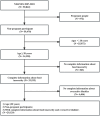A positive association between food insecurity and the prevalence of overactive bladder in U.S. adults
- PMID: 38370980
- PMCID: PMC10870421
- DOI: 10.3389/fnut.2023.1329687
A positive association between food insecurity and the prevalence of overactive bladder in U.S. adults
Abstract
Objective: This study aims to examine the correlation between overactive bladder (OAB) and food insecurity.
Methods: We conducted a cross-sectional analysis utilizing extensive population data derived from the National Health and Nutrition Examination Survey 2007-2018. The status of Household food insecurity is evaluated by the US Food Security Survey Module. To explore the relationship between food insecurity and OAB, three multivariable logistic regression models were carried out. Additionally, interaction and stratified analyses were also performed to find whether some factors have the potential to alter the correlation.
Results: There were 29,129 participants enrolled in the study. Compared to the other three groups, individuals with full food security exhibited a lower proportion of nocturia, urinary urgency incontinence, and OAB. In the fully-adjusted model, it was found that people experiencing food insecurity have a significantly higher prevalence of OAB compared to those with food security in the fully-adjusted model (OR = 1.540, 95%CI 1.359-1.745). Additionally, there was a significant association between the levels of food insecurity and an increased risk of OAB prevalence was also observed (marginal food security: OR = 1.312, low food security: OR = 1.559, and very low food security: OR = 1.759). No significant interaction was seen in the fully-adjusted model.
Conclusion: There is a strong positive correlation between food insecurity and the prevalence of OAB. Similarly, the correlation between levels of food insecurity and OAB also indicates the same trend. Namely, the more insecure food, the higher risk of OAB prevalence in the population.
Keywords: NHANES; food insecurity; nocturia; overactive bladder; urinary urgency incontinence.
Copyright © 2024 Xiao, Yin, Bai, Wang, Cui, Yang and Wang.
Conflict of interest statement
The authors declare that the research was conducted in the absence of any commercial or financial relationships that could be construed as a potential conflict of interest.
Figures
Similar articles
-
A positive association between the prevalence of circadian syndrome and overactive bladder in United States adults.Front Public Health. 2023 Aug 10;11:1137191. doi: 10.3389/fpubh.2023.1137191. eCollection 2023. Front Public Health. 2023. PMID: 37637821 Free PMC article.
-
Intake of dietary flavonoids in relation to overactive bladder among U.S. adults: a nutritional strategy for improving urinary health.Front Nutr. 2024 Jul 24;11:1437923. doi: 10.3389/fnut.2024.1437923. eCollection 2024. Front Nutr. 2024. PMID: 39114124 Free PMC article.
-
Associations between exposure to organophosphate esters and overactive bladder in U.S. adults: a cross-sectional study.Front Public Health. 2023 Nov 9;11:1186848. doi: 10.3389/fpubh.2023.1186848. eCollection 2023. Front Public Health. 2023. PMID: 38026372 Free PMC article.
-
The association between urinary cadmium exposure levels and overactive bladder syndrome in the U.S. adults from NHANES database.Sci Rep. 2025 Apr 15;15(1):12870. doi: 10.1038/s41598-025-97012-4. Sci Rep. 2025. PMID: 40234603 Free PMC article.
-
Global Prevalence of Overactive Bladder: A Systematic Review and Meta-analysis.Int Urogynecol J. 2025 Feb 14. doi: 10.1007/s00192-024-06029-2. Online ahead of print. Int Urogynecol J. 2025. PMID: 39951109 Review.
Cited by
-
Association of healthy eating index-2015 and overactive bladder: a cross-sectional study.Front Nutr. 2024 Sep 17;11:1400398. doi: 10.3389/fnut.2024.1400398. eCollection 2024. Front Nutr. 2024. PMID: 39355559 Free PMC article.
-
Financial Strain Across 25 years and Men's Lower Urinary Tract Symptoms: A Life Course Perspective.Am J Mens Health. 2025 Mar-Apr;19(2):15579883251330117. doi: 10.1177/15579883251330117. Epub 2025 Mar 31. Am J Mens Health. 2025. PMID: 40162920 Free PMC article.
-
Impact of consumption of vitamin D fortified foods on serum vitamin D concentrations and vitamin D status in families living in Pune, India: an effectiveness study.Eur J Nutr. 2025 Mar 1;64(2):105. doi: 10.1007/s00394-025-03624-x. Eur J Nutr. 2025. PMID: 40025346 Clinical Trial.
-
Interventions to reduce social isolation and food insecurity in older adults: a systematic review.Front Nutr. 2025 Jun 6;12:1607057. doi: 10.3389/fnut.2025.1607057. eCollection 2025. Front Nutr. 2025. PMID: 40547373 Free PMC article.
-
Different Detection Strategies of Pediocin-Like Produced by Pediococcus pentosaceus.Probiotics Antimicrob Proteins. 2024 May 2. doi: 10.1007/s12602-024-10271-x. Online ahead of print. Probiotics Antimicrob Proteins. 2024. PMID: 38696094
References
-
- Rogers RG, Pauls RN, Thakar R, Morin M, Kuhn A, Petri E, et al. . An international Urogynecological association (IUGA)/international continence society (ICS) joint report on the terminology for the assessment of sexual health of women with pelvic floor dysfunction. Neurourol Urodyn. (2018) 37:1220–40. doi: 10.1002/nau.23508, PMID: - DOI - PubMed
-
- Irwin DE, Milsom I, Hunskaar S, Reilly K, Kopp Z, Herschorn S, et al. . Population-based survey of urinary incontinence, overactive bladder, and other lower urinary tract symptoms in five countries: results of the EPIC study. Eur Urol. (2006) 50:1306–15. discussion 1314–1305. doi: 10.1016/j.eururo.2006.09.019, PMID: - DOI - PubMed
LinkOut - more resources
Full Text Sources



